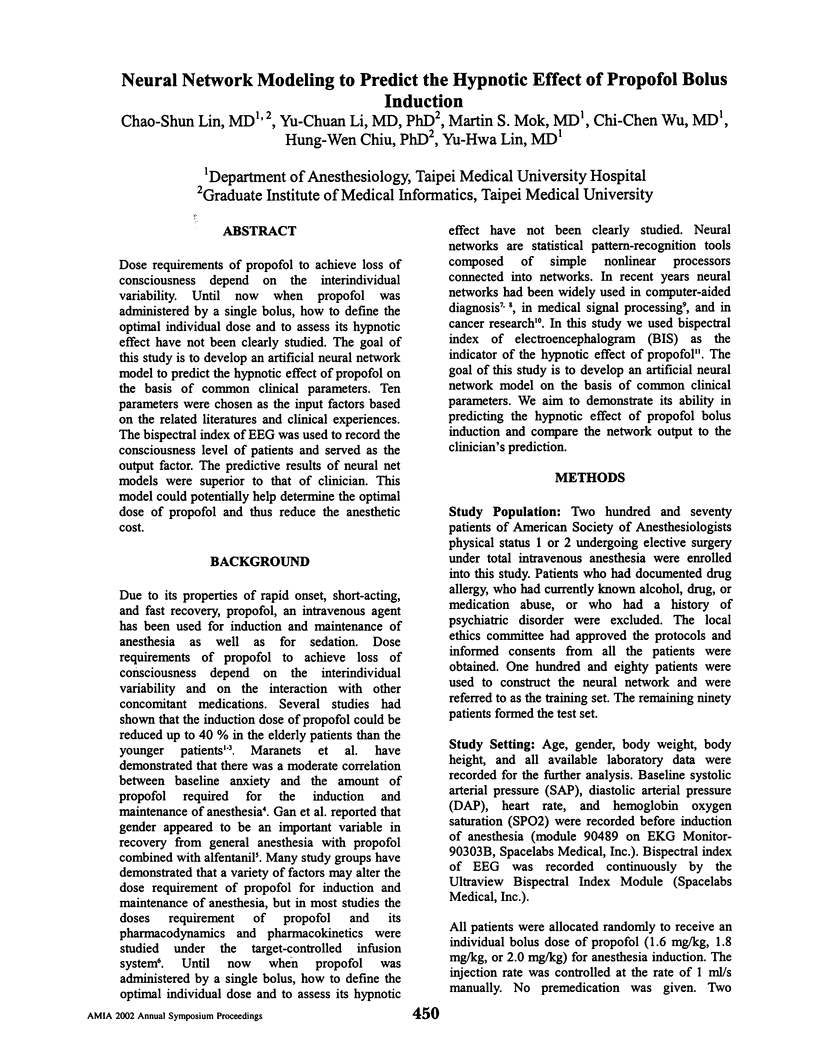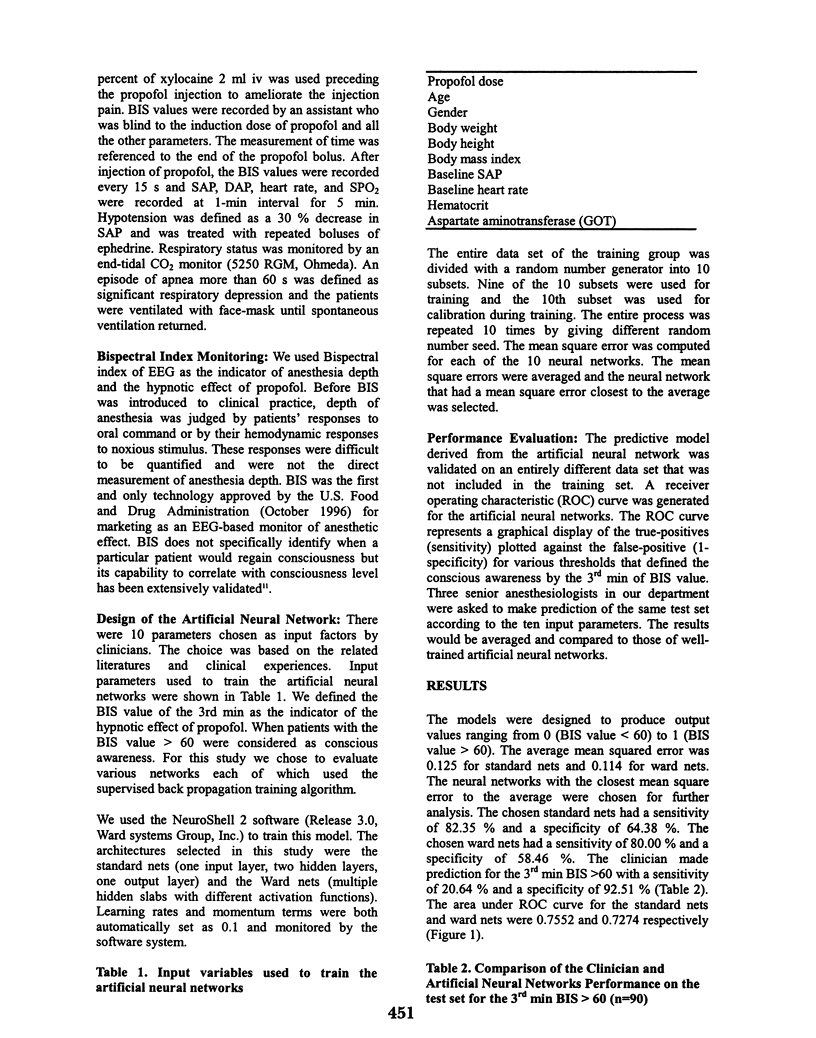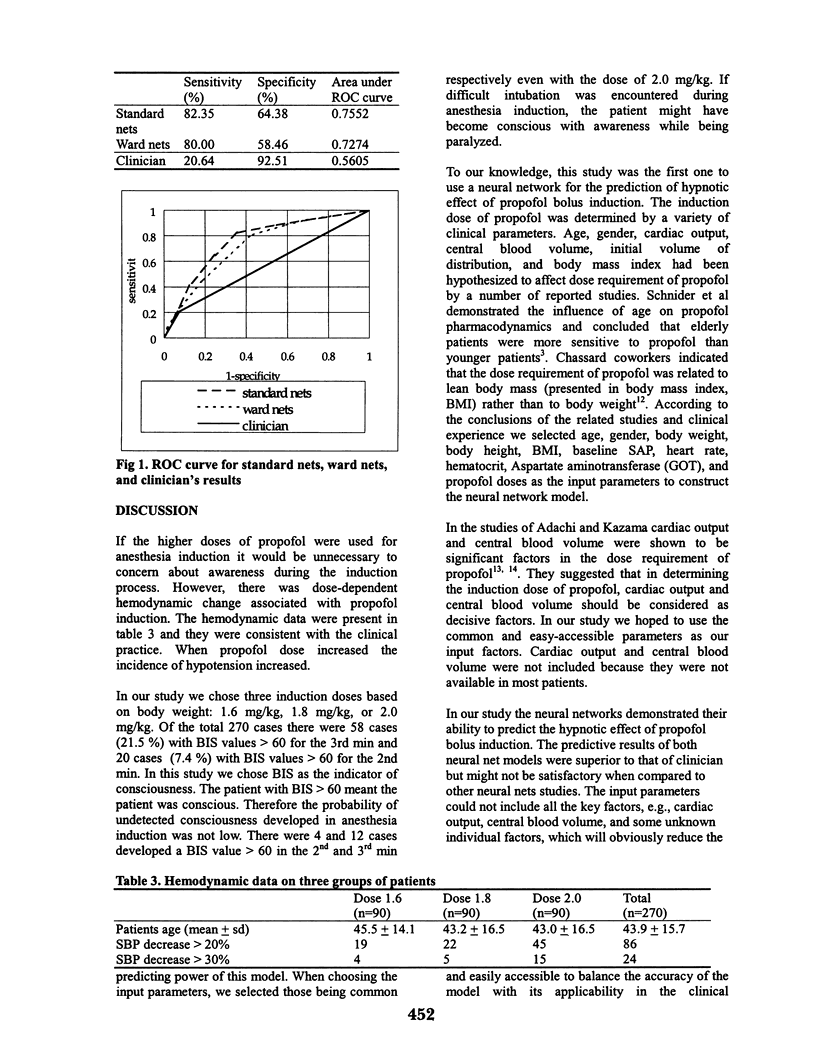Abstract
Dose requirements of propofol to achieve loss of consciousness depend on the interindividual variability. Until now when propofol was administered by a single bolus, how to define the optimal individual dose and to assess its hypnotic effect have not been clearly studied. The goal of this study is to develop an artificial neural network model to predict the hypnotic effect of propofol on the basis of common clinical parameters. Ten parameters were chosen as the input factors based on the related literatures and clinical experiences. The bispectral index of EEG was used to record the consciousness level of patients and served as the output factor. The predictive results of neural net models were superior to that of clinician. This model could potentially help determine the optimal dose of propofol and thus reduce the anesthetic cost.
Full text
PDF



Selected References
These references are in PubMed. This may not be the complete list of references from this article.
- Adachi Y. U., Watanabe K., Higuchi H., Satoh T. The determinants of propofol induction of anesthesia dose. Anesth Analg. 2001 Mar;92(3):656–661. doi: 10.1097/00000539-200103000-00020. [DOI] [PubMed] [Google Scholar]
- Ashizawa K., MacMahon H., Ishida T., Nakamura K., Vyborny C. J., Katsuragawa S., Doi K. Effect of an artificial neural network on radiologists' performance in the differential diagnosis of interstitial lung disease using chest radiographs. AJR Am J Roentgenol. 1999 May;172(5):1311–1315. doi: 10.2214/ajr.172.5.10227508. [DOI] [PubMed] [Google Scholar]
- Chassard D., Berrada K., Bryssine B., Guiraud M., Bouletreau P. Influence of body compartments on propofol induction dose in female patients. Acta Anaesthesiol Scand. 1996 Sep;40(8 Pt 1):889–891. doi: 10.1111/j.1399-6576.1996.tb04555.x. [DOI] [PubMed] [Google Scholar]
- Furness P. N., Levesley J., Luo Z., Taub N., Kazi J. I., Bates W. D., Nicholson M. L. A neural network approach to the biopsy diagnosis of early acute renal transplant rejection. Histopathology. 1999 Nov;35(5):461–467. doi: 10.1046/j.1365-2559.1999.035005461.x. [DOI] [PubMed] [Google Scholar]
- Gan T. J., Glass P. S., Sigl J., Sebel P., Payne F., Rosow C., Embree P. Women emerge from general anesthesia with propofol/alfentanil/nitrous oxide faster than men. Anesthesiology. 1999 May;90(5):1283–1287. doi: 10.1097/00000542-199905000-00010. [DOI] [PubMed] [Google Scholar]
- Johansen J. W., Sebel P. S. Development and clinical application of electroencephalographic bispectrum monitoring. Anesthesiology. 2000 Nov;93(5):1336–1344. doi: 10.1097/00000542-200011000-00029. [DOI] [PubMed] [Google Scholar]
- Kazama T., Ikeda K., Morita K., Ikeda T., Kikura M., Sato S. Relation between initial blood distribution volume and propofol induction dose requirement. Anesthesiology. 2001 Feb;94(2):205–210. doi: 10.1097/00000542-200102000-00007. [DOI] [PubMed] [Google Scholar]
- Maranets I., Kain Z. N. Preoperative anxiety and intraoperative anesthetic requirements. Anesth Analg. 1999 Dec;89(6):1346–1351. doi: 10.1097/00000539-199912000-00003. [DOI] [PubMed] [Google Scholar]
- Miller A. S., Blott B. H., Hames T. K. Review of neural network applications in medical imaging and signal processing. Med Biol Eng Comput. 1992 Sep;30(5):449–464. doi: 10.1007/BF02457822. [DOI] [PubMed] [Google Scholar]
- Olmos M., Ballester J. A., Vidarte M. A., Elizalde J. L., Escobar A. The combined effect of age and premedication on the propofol requirements for induction by target-controlled infusion. Anesth Analg. 2000 May;90(5):1157–1161. doi: 10.1097/00000539-200005000-00029. [DOI] [PubMed] [Google Scholar]
- Peacock J. E., Spiers S. P., McLauchlan G. A., Edmondson W. C., Berthoud M., Reilly C. S. Infusion of propofol to identify smallest effective doses for induction of anaesthesia in young and elderly patients. Br J Anaesth. 1992 Oct;69(4):363–367. doi: 10.1093/bja/69.4.363. [DOI] [PubMed] [Google Scholar]
- Scheepstra G. L., Booij L. H., Rutten C. L., Coenen L. G. Propofol for induction and maintenance of anaesthesia: comparison between younger and older patients. Br J Anaesth. 1989 Jan;62(1):54–60. doi: 10.1093/bja/62.1.54. [DOI] [PubMed] [Google Scholar]
- Schnider T. W., Minto C. F., Shafer S. L., Gambus P. L., Andresen C., Goodale D. B., Youngs E. J. The influence of age on propofol pharmacodynamics. Anesthesiology. 1999 Jun;90(6):1502–1516. doi: 10.1097/00000542-199906000-00003. [DOI] [PubMed] [Google Scholar]
- Snow P. B., Kerr D. J., Brandt J. M., Rodvold D. M. Neural network and regression predictions of 5-year survival after colon carcinoma treatment. Cancer. 2001 Apr 15;91(8 Suppl):1673–1678. doi: 10.1002/1097-0142(20010415)91:8+<1673::aid-cncr1182>3.0.co;2-t. [DOI] [PubMed] [Google Scholar]


